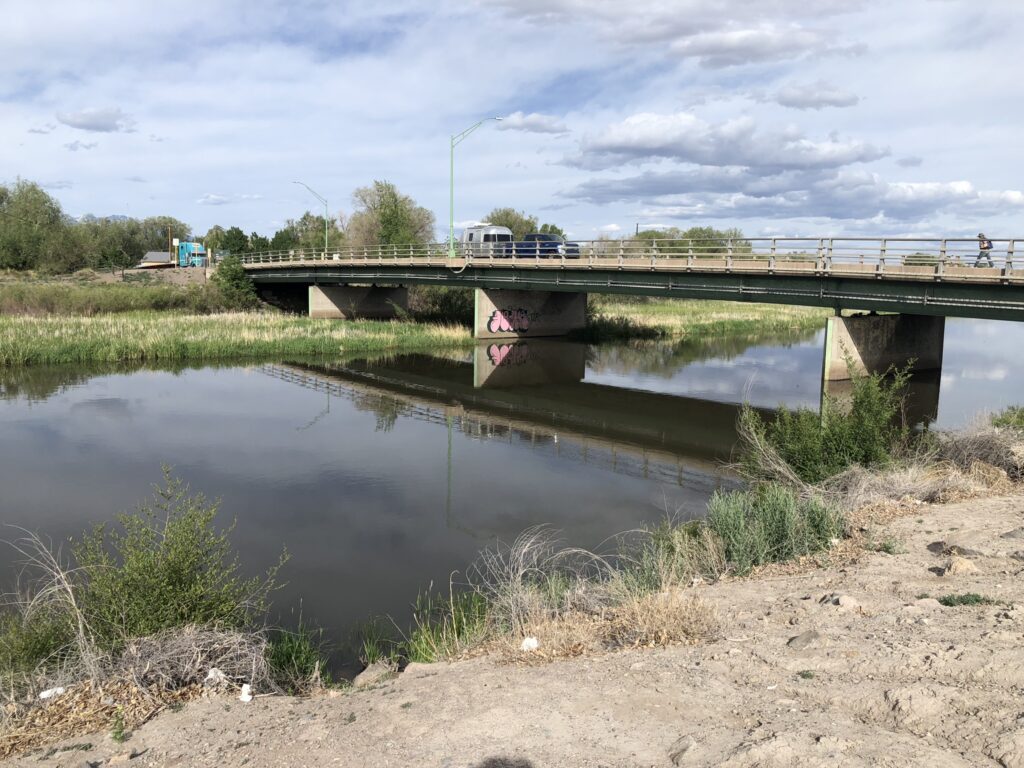ALAMOSA, COLORADO – Meandering toward Boulder for this week’s Getches-Wilkinson Center Colorado River conference, I stopped this evening in Alamosa, Colorado, in the San Luis Valley. I love the drive up the back way, through the San Luis Valley and into the heart of the Rockies, and I split it up into a couple of days this year to get some bike riding in.
Long western drives have always been a part of my process, quality thinking time, and the San Luis Valley is a great writing prompt. It’s broad, high, pan flat, and a really good place to grow alfalfa and potatoes. (There’s a flatbed of alfalfa in the Walmart parking lot next to my motel, headed for a dairy somewhere – future burgers and pizza cheese.)
When the railroad and the Mormons arrived in the 1800s, they starting growing a lot of stuff to export, reducing the flow in the Rio Grande which, through a series of knock-on effects, led us in central New Mexico to import Colorado River water via the San Juan-Chama Project, which is why I’m headed to Boulder. For want of a nail….
Foundations of the Law of the River: Shaky
It’s the San Juan-Chama linkage – critical to Albuquerque’s water supply – that got me started working on Colorado River issues nearly 20 years ago, which led to a couple of books (Water is For Fighting Over, Science be Dammed) a growing list of academic publications, and this crazy blog, which I’m happy to report Emily Guerin called “influential”! The second book was a collaboration with Eric Kuhn, and during the years working at it we more than once met up at the Holiday Inn Express in Alamosa, midway between his home in Glenwood Springs and mine in Albuquerque, holed up in the breakfast area working through chapters. Is it possible to have fond memories of a Holiday Inn Express breakfast area? I do.
The collaboration continues, joined by my Utton Center colleague Rin Tara, with a couple of new papers digging into the history of the development of the Upper Colorado River Compact and its implications for 21st century river management. A preprint of the first of the two papers, a deep dive into the negotiation history, went up over the weekend and I already blogged about it.
A preprint of the second paper, Unfinished Business: 21st Century Questions Posed by Ambiguities in the Upper Colorado River Compact and the Law of the River, went up this morning. It’s our attempt to work through the modern implications of that history for 21st century river management:
The Law of the River, particularly those components relating to Upper Colorado River water allocation, usage, and measurement, is rife with ambiguities and uncertainties. In the 21st Century, facing a future with less water, these ambiguities pose serious problems. The ongoing process for the development of the Post-2026 Colorado River Operating Guidelines presents an ideal opportunity to address these issues. This article gives a brief history of the Law of the River, with an eye towards the origins of the Stream Depletion Theory, beneficial consumptive use, and Tribal water allocations. The authors then discuss potential resolutions to these three problems. The article concludes by urging water leaders in the Upper Colorado River Basin to consider these solutions in their development of Post-2026 guidelines
All three of us will be in Boulder for Getches Wilkinson, say hi, we’d love to talk about this stuff!

